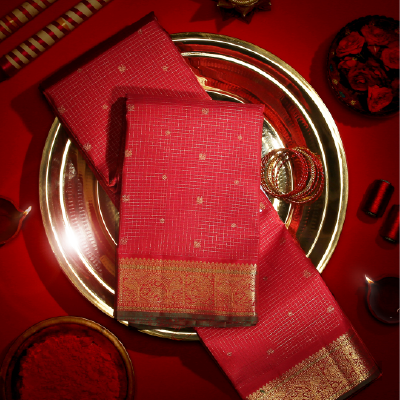Navratri is the official start to the festive season. Each day of Navratri is dedicated to the nine avatars of the Goddess Durga and each of these colours symbolises her qualities. As we partake in the season's festivities and celebrations, let us have a look at the significance of the colours of Navratri this year.
Day 1: Maa Shailaputri
The first day of Navratri is dedicated to Maa Shailaputri. She is the daughter of the Himalayas and is also known as Parvathi or Hemavati. She fulfils all the desires of the heart and blesses one with positivity and success.
The colour of the first day of Navratri this year is White and it signifies peace, purity and freshness.


Day 2: Maa Brahmacharini
Maa Brahmacharini is the second incarnation of Goddess Durga and is worshipped for virtue, peace, prosperity, happiness and nobility.
Red is a powerful colour which signifies beauty and courage. Celebrate the second day of Navratri wearing a radiant red silk saree.


Day 3: Maa Chandragatha
Synonymous with strength, power and grace, Maa Chandragatha is believed to be the epitome of generosity and compassion. She is also known as the Goddess of War and blesses her devotees with courage and confidence.
The colour blue symbolizes spirituality, and calm yet powerful energy, just like Maa Chandragatha.


Day 4: Maa Kushmanda
Maa Kushmanda, the 4th form of Goddess Durga, is said to bring wealth and health to the lives of those who worship her. She is the carrier of light and illumination which guides those who tread on the path of darkness.
The colour of the fourth day of Navratri is yellow which is a cheerful colour that signifies happiness, peace, prosperity and positivity.


Day 5: Maa Skandamata
Symbol of fertility and motherhood, Maa Skandamata is worshipped on Panchami, which falls on the fifth day of Navratri. She is celebrated for her benevolence, and strength and blesses her devotees with peace, safety, fearlessness, power and prosperity. She is also referred to as the one who does not fear.
Rejoice in the celebrations of the 5th day of Navratri by wearing a green colour saree which represents agricultural prosperity, spiritual knowledge, growth and new beginnings.


Day 6: Maa Katyayani
By seeking the blessings of Goddess Katyayani, one develops the strength to fight his or her sorrows, illness and fears. She is also known as the warrior goddess and symbolises the destruction of negativity and ego.
On the 6th day of Navratri, devotees wear grey colour while worshipping Maa Katyayani. The colour is associated with removing darkness from one’s life and filling it with hopes for a better future ahead.


Day 7: Maa Kalratri
Goddess Kaalratri is described as the fiercest and most ferocious form of Goddess Durga and is her 7th incarnation. She is the destroyer of negative energies and blesses her devotees with the power to face difficult situations in life.
The 7th day of Navratri is to be celebrated by wearing an orange colour saree which symbolises happiness, positivity and good fortune.


Day 8: Maa Mahagauri
Maa Mahagauri has the power to fulfil all the desires of her devotees. She is also known as the Goddess of peace and endurance and is a representation of purity, tranquillity and serenity.
The colour associated with the 8th day of Navratri is peacock green which signifies strength, intelligence, confidence, rejuvenation and freedom.


Day 9: Maa Siddhidatri
The last day of Navratri is observed to Maa Siddhidatri, She is the remover of obstacles in one’s life and blesses one with the strength to achieve all their goals in life.


The pink colour is significant on this day as it symbolizes hope, confidence, optimism and a fresh start. Sundari Silks presents a wide range of beautiful silk sarees in the hues of Navratri for the grand galas and intimate gatherings that this festive fortnight has in store. You can shop our collection at www.sundarisilks.com





